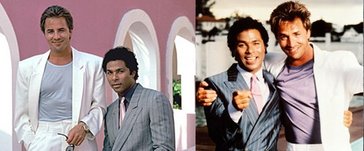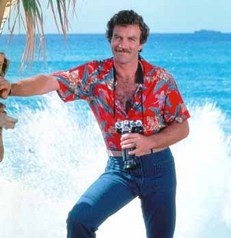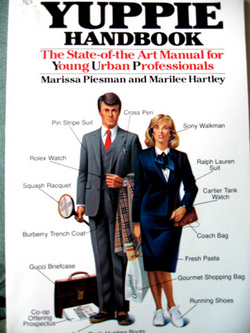Miami Vice Look

Image courtesy of http://www.cozi.com/live-simply/greatest-fashion-fads-80s-90s
The 1980s brought an explosion of colorful styles in men's clothing. The look of several popular TV stars helped to set fashion trends among young and middle-aged men.
Miami Vice was one such series, whose leading men donned casual t-shirts underneath expensive suit jackets—often in bright or pastel colors. The t-shirt-with-designer-jacket look was often accompanied by jackets with broad, padded shoulders, and a few days' growth of facial hair, dubbed "designer stubble", a look popularized by the series' leading man Don Johnson.
Miami Vice was one such series, whose leading men donned casual t-shirts underneath expensive suit jackets—often in bright or pastel colors. The t-shirt-with-designer-jacket look was often accompanied by jackets with broad, padded shoulders, and a few days' growth of facial hair, dubbed "designer stubble", a look popularized by the series' leading man Don Johnson.
Hawaiian Shirt

Similarly, another popular look for men beginning in the early 1980s was the Hawaiian shirt, as worn by Tom Selleck, star of television's enormously popular detective series Magnum, P.I..Thanks to Magnum, P.I., Hawaiian shirts sales soared (as did the numbers of men, of all walks of life, sporting mustaches), complemented with sport coats, often with top-stitched lapels for a "custom-tailored" look). In counterpoint to the bright shirt, jackets were often gray, tan, rust or white, donned casually and in sunny locales doubled even as business attire, in which case they could be seen worn with a tie. Easy-care micro-suede and corduroy jackets became popular choices, especially those with a Western style. Cowboy boots, in the early 1980s, became popular even among non-cowboys. Some boots were remarkably expensive, such as those made by Lucchese, which could cost $500 a pair. Also in vogue--and also expensive--were Gucci loafers, as worn byTom Selleck in a famous cologne advertisement.
Image courtesy of http://www.wolfgnards.com/index.php/2010/01/07/hawaiian-shirts-in-film
Members Only Jackets
Another off-the-charts look for young men that emerged in the early 1980s was the "Members Only" jacket, its brand name conspicuously displayed on the front left breast pocket. It was a golf style windbreaker, with a slim mandarin-style collar. To see more about this trend click here.
Preppy

Contemporaneously, there was a resurgence of another look, a throwback to the earlier 1950s collegiate look or Ivy League look. Its wearers and advocates rallied against the more trendy styles cited above. This revival style held great snob appeal, and came to be definitively summarized in an enormously popular paperback:The Official Preppy Handbook. This "preppy" cultural backlash spread like wildfire, inspiring a deep-seated social sensibility that extended to and included all manner of consumables and socialization. Preppies eschewed micro-suede jackets, instead favoring a classic single or double-breasted blazer in navy blue or midnight blue seasonal weight wool or linen. The truly privileged favored an English bespoke shouldered pattern, double vented. All styles boosted gold-tone or actual gold buttons; ideally, for total snob appeal, the buttons were engraved with the owner’s initials or an alma mater’s insignia. Beneath the blue jacket, Preppies donned a variety of shirts; prized were candy-stripes and solid colors; flashy Hawaiian patterns or designs were to be avoided, at all costs, to protect one’s perceived upper-class status.
Significantly, then, it can be said that the 1980s men’s fashion scene was transfigured by a social class consciousness, whereto, expressing this tacit and exclusionary “code” for a man’s dress were parameters that determined his social status, as codified aptly in the Lisa Birnbach’s et al., The Official Preppy Handbook. Purportedly, such “in the know” standards came to be indicative of one’s background, education and upper class. Some sociologists would avoid or attempt discounting that pivotal, authoritative and tacit but insidious and fully dichotomous aspect of that American period in men’s fashion, which quickly came to far exceed in importance mere fashion statement.
However, that all said, by the mid-1980s European and US designers' popularity and re-focus on classical mens styles had captured yet another segment of the mens fashion market, which in a manner of speaking attracted a following from both the preppy and non-preppy mindsets.
Significantly, then, it can be said that the 1980s men’s fashion scene was transfigured by a social class consciousness, whereto, expressing this tacit and exclusionary “code” for a man’s dress were parameters that determined his social status, as codified aptly in the Lisa Birnbach’s et al., The Official Preppy Handbook. Purportedly, such “in the know” standards came to be indicative of one’s background, education and upper class. Some sociologists would avoid or attempt discounting that pivotal, authoritative and tacit but insidious and fully dichotomous aspect of that American period in men’s fashion, which quickly came to far exceed in importance mere fashion statement.
However, that all said, by the mid-1980s European and US designers' popularity and re-focus on classical mens styles had captured yet another segment of the mens fashion market, which in a manner of speaking attracted a following from both the preppy and non-preppy mindsets.
Images courtesy of http://wasp101.blogspot.com/2010/07/finally-second-helping.html, http://www.minyanville.com/investing/articles/jcp-rl-m-ANF-lacoste-brby/4/14/2009/id/21997 and http://francisanderson.wordpress.com/2007/11/26/links-for-2007-11-27/yuppie/
Source: “1980s in Fashion.” Wikipedia, the Free Encyclopedia. Wikimedia Foundation, Inc. 14 Apr. 2011. Web. 15 Apr. 2011.
